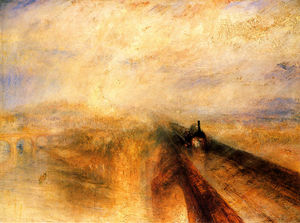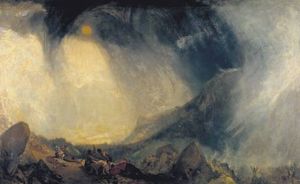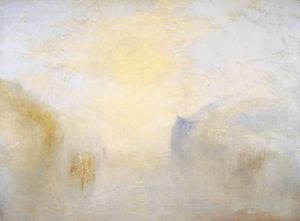Joseph Mallord William Turner
- Short Name:
- Turner
- Date of Birth:
- 23 Apr 1775
- Date of Death:
- 19 Dec 1851
- Focus:
- Paintings
- Mediums:
- Oil, Watercolor, Prints
- Subjects:
- Landscapes, Scenery
- Art Movement:
- Romanticism
- Hometown:
- London, United Kingdom
- Joseph Mallord William Turner Page's Content
- Introduction
- Artistic Context
- Biography
- Style and Technique
- Who or What Influenced
- Works
- Followers
- Critical Reception
- Bibliography
Introduction
Joseph Mallord William Turner is often described as the 19th century's greatest landscape painter. He was fascinated by the powers of nature and transferred this passion onto canvas.
In his later works he focused on the new abilities of the machines of the industrial revolution and he led a long and successful career.
As a leading Romantic painter focusing mainly on color and lighting, Turner's works went on to later influence the Impressionist movement.
Joseph Mallord William Turner Artistic Context
Romanticism is sometimes viewed as a reaction to its more serious predecessor, the Neoclassical movement. As Neoclassical artists focused on properly accounting history through close attention to detail, Romantic artists flirted with themes of man's self glorification, man's part in nature, divinity found in nature, and emotion.
Though Neoclassicism is generally associated with the history genre, Turner is credited with having embarked on a subject matter so great that it actually rivaled the history genre. His subject matter accounts for recording history, but in a different style than ever seen before. He used color to intensify emotion in portraying the passing of events.
Joseph Mallord William Turner Biography
J. M.W. Turner began his artistic career at a very young age and his success was almost immediate, selling his first painting at just 12 years old. Turner continued to accomplish significant achievements at a remarkably young age, some that people with much more experience would never have the privilege of enjoying.
Throughout his career Turner remained highly sought-after and he acquired a very large fortune from his commissions. He is remembered as an influential painter and is said to be the best landscapist of the 19th century. Turner was also a key inspiration for the Impressionist movement. He is most well-known for his original interpretations of bringing light and color to his paintings.
Joseph Mallord William Turner Style and Technique
Turner displayed an evident evolution in his painting style throughout his long career. Though he stayed true to the genre of landscape, as his career progressed he began to pay less attention to the details of objects and landscape and more attention to the effects of light and color. He became increasingly fascinated with natural and atmospheric elements.
Style:
Early Years:
In Turner's early paintings he executed dramatic, Romantic subjects by emphasizing luminosity, and atmosphere. One can observe a more precise attention paid to architectural and natural details in his early years, as compared to his later years.
During this time, he played around with all the styles of landscape composition including historical, architectural, mountainous, pastoral and marine. His series of 71 etchings, inspired from his existing paintings and watercolors, show all of these styles (1807-1819).
Middle Years:
Turner's painting style shifted during the 1880s. His painting became more luminous and atmospheric. He began to focus more on color than the details of the actual topography. St. Mawes at the Pilchard Season (1812) is an example.
Frosty Morning (1813) is based solely on the effects of light. As time progressed he paid less attention to specific details and more to atmospheric quality created by the natural elements, such as the sun.
Advanced Years:
Still, less and less attention is given to detail, while his canvas now begin to assume a suggestion of movement. His Norham Castle, Sunrise and With A Boat Between Headlands are both examples of slightly brushed canvases, mere color notations.
Some of his more famous later paintings, he approaches the subject of modern technology. He pays a tribute to the passing age of sail ships that were soon to be replaced by steam-powered vessels. He moves away from marine subject matter, and focuses now on the railway in Rain, Steam, and Speed-the Great Western Railway (1844). This is a prime example of how Turner focused mainly on colors and the idea of fluidity through his whirling colors.
Method:
Turner's watercolor paintings provided a later influence on his technique with oil paint. He started to use oil paint in a translucent manner, similar to the effect of water color, which helped produce his original style.
Before painting a vast majority of his work, as many of his subjects (mainly water) changed so quickly, he had to do preliminary sketches. He later turned his sketches in to watercolor or oil paintings.
Who or What Influenced Joseph Mallord William Turner
Like most artists, Turner was heavily influenced by the masters that came before him. After closely studying the techniques of fellow Romantic landscape artists, both John Robert Cozens and Richard Wilson, Turner began to develop his own unique style. He spent time studying at the Louvre, viewing the work of other artists and honing in on his craft. His greatest influence however, came during his travels when he witnessed nature and all its grandeur live and in person.
Chronological Order of Influences:
As a young artist Turner (circa 1797) was employed to make reproductions of the unfinished work of the late landscapists, John Robert Cozens. Cozens, a fellow English romantic painter, had a lasting influence on Turner by his use of watercolors to create his luminous atmospheres. The similarities can be seen in the light treatment between the two artists.
Fellow landscapist, Richard Wilson, is credited as having revealed to Turner a more poetic and imaginative approach to landscape. Wilson was greatly commissioned by the aristocrats and even the royal family. His love for landscapes was said to be the cause of the loss of his fortune, as they were the least commissioned of his work.
Aside from style, his travels were the main inspiration for the content of his work. His travels throughout England, to Wales, Scotland, and through the European continent profoundly affected his work. His tour of Switzerland and France resulted in 400 drawings, which he later drew from to create beautiful painted landscapes. During his time in France he studied the Old Masters of art at the Louvre.
He took a strong liking to the marine activity, a subject often encountered in his work.
Joseph Mallord William Turner Works
Joseph Mallord William Turner Followers
The majority of Turner's followers came after his death. He had the greatest recognized influence on the Impressionist, and Post-Impressionist movements. The ripple effect of his innovations can still be seen in the art of today's landscape painters.
Contemporary followers:
Though his talent was widely recognized during his day, not much is said of Turner's followers during his lifetime.
Posthumous:
A widely recognized group of Turner's followers were the Impressionists. Turner is said not only to have influenced Impressionist painters, but also Impressionist musicians.
Turner's abstract portrayal of light and the elemental forces of nature laid the ground work for impressionism and post impressionism. His observed nature and he challenged the conventional formulas of representation. His fascination with light is a concept said to have transcended from the canvas to even influence Impressionist musicians.
Impressionist art is characterized by the impression of objects or a scene through reflected light. It may be obscure, repetitive in effect and displays the appeal of color. The same goes for music, which also can be vague but still somehow demonstrate color.
Followers Today:
Turner continues to be talked about in blog pages and websites. Fans continue to praise his art and comment on how influential he has been to their own art.
Joseph Mallord William Turner Critical Reception
Throughout his career, Turner was a well-liked and highly sought-after artist. During his early days, the Royal Academy praised his work. Though patrons were willing to pay top dollar for his paintings, there were of course conservative critics who attacked Turner's compositions. A revival of interest in his work took place during the 20th century.
During Life:
As a young emerging artist of the early 19th century, conservative critics disapproved of Turner's "dynamic compositions" and shocking colors. This critical outlook did not influence the public however; Turner had enough commissions to last him a lifetime. His popularity increased further during the mid 19th century after John Ruskin, English art critic, pronounced Turner as superior to all previous landscape painters in his book Modern Painters (1843).
As a young emerging artist of the early 19th century, conservative critics disapproved of Turner's "dynamic compositions" and shocking colors. This critical outlook did not influence the public however; Turner had enough commissions to last him a lifetime. His popularity increased further during the mid 19th century after John Ruskin, English art critic, pronounced Turner as superior to all previous landscape painters in his book Modern Painters (1843).
After Death:
Turner's work was still admired after his death mostly so by fellow artists, the Impressionist. They admired his work for Turner depicted a moment in an ever-changing scene (turmoil of a storm, a sunset etc) masterfully, and with a beautiful attention paid towards color and light. These characteristics greatly influenced the Impressionist movement. The rebirth of interest in Turner's art occurred in the 20th century. He is recognized today as an innovative and technically accurate painter. Appreciation for his abstract qualities and use of color and light continues to grow even today.
Joseph Mallord William Turner Bibliography
Volumes have been written about Romanticism and Turner's contribution to this exciting movement. Below is a selection of some recommended works for further reading about this fascinating movement in art.
Books:
• Brennan, Matthew. Wordsworth, Turner, and Romantic Landscape. Columbia, SC. : Camden House, 1987
• Finley, Gerald. "Turner and the Steam Revolution. " Gazette Des Beaux-Arts 112 (1988): 19-30
• Gaunt, William. Turner. Oxford: Phaidon Press, 1971
• Klingender, F. D. Art and the Industrial Revolution. 1947. Ed. Arthur Elton. London: Evelyn, Adams & Mackay, 1968
• Lindsay, Jack. J. M. W. Turner: A Critical Biography. London: Cory, Adams and Mackay, 1966
• Reynolds, Graham. Turner. New York: Harry N. Abrams
• Rothenstein, John, and Martin Butlin. Turner. New York: George Braziller, 1964
























